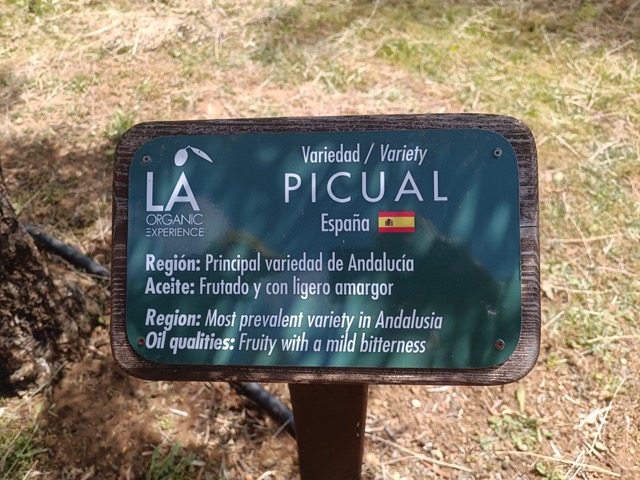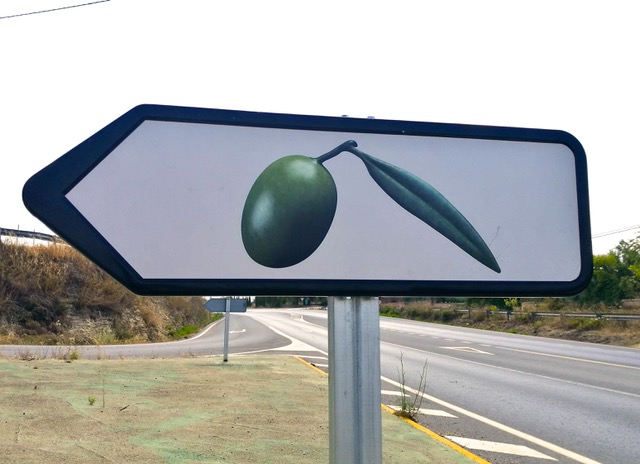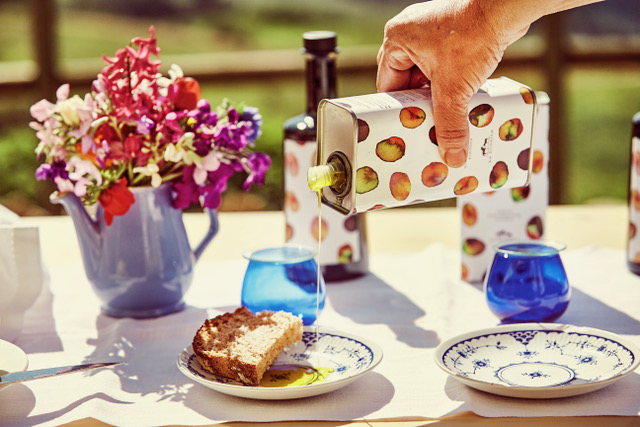
Organic olive oil tasting in the open air. Photo © Finca La Donaira
In Andalucía, we have almost unlimited possibilities to participate in wine tastings - in vineyards, bodegas, or even wine shops. One learns to distinguish between young and well-aged wine, understand the concept of terroir, know whether the wine comes from sweeter or drier grapes, and try to recognize the wide variety of flavours and aromas - from old wood to berries and roses. But what about Olive oil, another product for which the Andalucía region is at least as famous? How does one taste el oro líquido? ‘The liquid gold’ as it is called has as many aromas and flavour varieties, an equally long and fascinating history, and sommeliers who specialize in classifying olive oil. Let us therefore take a closer look at the quality assessment of this oil that has been produced for more than 6000 years and of which Spain produces more than any other country so that you can do your very own olive oil tasting.
The fruit

Olive. Photo © Karethe Linaae
Extra virgin olive oil is the highest quality olive oil and the products I refer to here. Olive oil is among the healthiest fats you can use, but in addition to the health benefits, the oil is delightful to taste.
There are more than a thousand olive tree varieties that grow on six of the world's seven continents. However, 85 % of all olive production comes from 139 species that are grown in 23 countries – with Spain in the top position. 90 % of the fruit from the trees is turned into olive oil, which gives opportunities for endless variations in taste, aroma, consistency, colour, and quality.

Century-old olive tree at LA Organic. Photo © Karethe Linaae
Olive oil made from a single variety is called monovarietal, while oils made of two or more varieties are called coupage. It is estimated that almost 1/3 of the world’s olive oil production comes from the variety called Picual. Arbequina is the second most common with around 10 % of the global production, while the third most common is Hojiblanca, and all these three species are of Spanish origin. Simultaneously, new varieties are created every year by crossing species to create so-called genetic improvements according to the taste preferences of today’s consumers. However, according to the specialists, no olive oil is ‘better’ than others, as the choice ultimately lies in the taste buds of the consumers.

The most common olive variety is Picual from Spain. Photo © Karethe Linaae
Methods and parameters for olive oil classification are regulated by The International Olive Council (IOC). The quality and taste of the oil can depend on a variety of factors such as soil quality, the health of the tree, and the production process used, in addition to temperature, light, and hygiene conditions as well as packaging. During production, several issues can arise that can affect the quality of the oil. Therefore, when you open a Premium bottle of olive oil, remind yourself of the love and effort and the long and complicated process that has gone into creating a harmonious and well-balanced product.
Olive oil sommeliers

A selection olive oils. Photo © Karethe Linaae
While the demand for cooking oils and affordable olive oils has decreased recently due to the increases in the market price, the demand for exclusive extra virgin olive oil as well as the interest from consumers and professionals has grown tremendously in the last couple of decades. This has led to more competitions that award the best olive oils on the market and given more opportunities for consumers to learn more about the art and joy of olive oil tasting.
The French word Sommelier refers to a cellar master who specializes in all aspects of wine as well as the pairing of wine and food. An olive oil sommelier, on the other hand, is a specialist in identifying different types of olive oil, their flavour profiles, and their uses.

Some organic olive oil varieties. Photo © LA Organic
Each type of olive oil has its unique taste, smell, and texture. While a low-quality olive oil only tastes and smells like oil, a good olive oil should have the aroma and taste of fresh herbs and fruits, with a range of profiles from delicate to complex. Experts describe for example the Picual oil as "rural, with a perfect balance between bitterness and spice, and an echo of tomato plants, artichoke plants, beans, and olive leaves". Arbequina oil has a fruity aroma reminiscent of apple, banana, and pears, and is said to be sweeter and milder than other varieties. In contrast, the Hojiblanca oil is described as herbaceous, medium spicy, and not too bitter. It is precisely this complexity and the rich nuances in aroma, colour, and taste that make olive oil so unique and different from other vegetable oils.
Smell and taste sensations

The taste buds. Photo Karethe Linaae
The sense of smell is the most sensitive sense we have. It is stimulated by air molecules and volatile compounds that are transported to the nose, mouth, and finally to the brain. Olive oil aroma is the result of complex mixtures of volatile compounds that vary according to the quality of the oil. Contrary to what one might think, a high-quality oil will have a simpler profile than a low-quality oil that will present more volatile compounds that create unpleasant aromas from enzymatic and chemical treatments.
Four basic tastes are normally recognized in our Western culture: sweet, sour, salty, bitter, and umami (meaty flavour). Sweetness, which is perceived in the first second and disappears within ten seconds, is felt on the tip of the tongue - all you need is to moisten the tip of the tongue in the oil. A sour taste is perceived along the sides and back of the tongue, salt is perceived along the sides, but not on the surface of the tongue, and bitterness is felt at the back of the tongue and lasts the longest. Spiciness is not a taste stimulus as such, but the sensation can be experienced throughout the oral cavity and is most noticeable in the throat (as with spicy food). Bitterness and spiciness are otherwise considered positive qualities in a good olive oil.
Although the subjectivity of human sensory analysis is greater than when using technical systems, it is currently the only authorized way to classify olive oil. The analysis is done by certified taste panels that assess appearance, smell, taste, tactile, and kinesthetic elements that are identified on a scale from pleasant to unpleasant.
Going to an olive oil-tasting

Sign to LA Organic. Photo © Karethe Linaae
Many large and medium-sized olive oil producers in Andalucía offer olive tasting for groups or individuals. The easiest thing is to Google cata degustación de aceites de oliva in the area where you wish to try the oil. In the province of Málaga, we have partaken in fabulous olive oil tasting in the open air at the exclusive organic resort La Donaira outside the mountain village of Montecorto.

Olive oil tasting in the open air. Photo © Finca La Donaira
If one is a family, a group of friends, or a slightly larger group, I would however recommend the experimental organic olive growing facilities LA Organic outside Ronda. When we were there recently, we were shown a short video about olive cultivation before our guide Andrés took us on an hour stroll around the vast grounds as he explained the process, surrounded by centuries-old olive trees, fragrant herbs, and artwork by Philippe Starck. The tour ended back in the reception hall with a tasting of their organic olive oils. Here you learn to distinguish between a so-called mild olive oil (Coupage of 80% Arbequina, plus Picual and Hojibanca) and an intense oil (100% Picudo). The latter oil was awarded as the world's best organic extra virgin olive oil in 2015 and has been one of the top five in the world ever since. The tasting starts with trying the oils for yourself and ends by dipping bread into the liquid gold, possibly with a splash of vinegar made from Pedro ximénez sherry. Simply heavenly!

Olive oil tasting. Photo © LA Organic
Try it yourself!
Even if you are not an expert, you can try at home with two or three types of quality olive oil. To experience the true taste of the oil, this is done without other food.
The first sense you use is your eyes. Note the colour and consistency of the oil as you pour it from the bottle. (Since quality olive oil should never be stored on clear glass or in plastic, one should not be able to see the oil until it comes out of the bottle). The olive oil can be golden, a sunny yellow colour, or a greenish shade if it is a fresher and/or unfiltered oil.
Pour 1-2 tbsp. oil in a small glass cup/bowl. Professionals most often use cobalt blue glass with a glass lid, but you can also use a small stemless wine glass.

Observe the oil's colour and consistency. Photo © LA Organic
Cover the top of the glass (a cardboard coaster is perfect) and let it sit in your hand, so the oil warms up naturally until you're ready to smell it. The ideal temperature for tasting olive oil is 28 degrees.
Swirl the oil gently in the glass to release the aromas. You can smell an intense oil from a greater distance than a mild one. Experiment with bringing the glass further away from and then closer to your nose. Place the tip of your nose near the edge of the glass and inhale deeply. What aromas do you detect?
Taste the oil first by touching it with the tip of your tongue. What are the sensations? Take a sip the size of a tablespoon. Slurp (like tasting a fine wine) to emulsify the oil and disperse it in the mouth, as this helps to release the flavours. What are the taste sensations you get? Is the aroma pleasant, mild, strong, or somewhere in between?
Swallow slowly. Do you feel bitterness on the back of your tongue, and if so, how intense is it? Is the oil bitter or spicy, so that you feel it in your throat when you swallow?
Taste one oil at a time and follow the same process: eyes, nose, lips, tongue, oral cavity, and throat. A milder oil is more suitable for cooking salads and can be combined perfectly with vinegar, while an intense oil is like a mature whisky that you take out for special occasions.

Olive oil with bread - simply a delicacy. Photo © Karethe Linaae
In the same way that wine connoisseurs use all the words in the world to describe a wine, olive oil connoisseurs might describe the aroma and flavour of olive oil with words such as tomato plant, artichoke plant, cinnamon, eucalyptus, grass, green fruit, almond, banana, tea, mint, pine, butter, flowers, nuts, ripe fruit, black pepper, cherry, citrus, hay, and wood.
Personally, I have a hard time describing wine as an old tobacco pouch or olive oil as a green banana, but if I close my eyes and take in the aromas and flavours, I can almost imagine myself lying in a meadow of wildflowers while long straws sway their heads in the breeze on a sunny Andalusian early summer day.
Try it yourself and see where the taste experience brings you!

Olive trees. Photo © Karethe Linaae